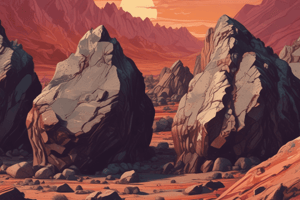Podcast
Questions and Answers
What is an igneous rock?
What is an igneous rock?
- Rocks formed from sediment deposition.
- Rocks that are formed under extreme pressure.
- Rocks that result from the erosion of other rocks.
- Rocks formed by the cooling and solidifying of molten materials. (correct)
What is an intrusive rock?
What is an intrusive rock?
Igneous rock formed from magma forced into older rocks at depths within the Earth's crust.
What is an intrusive body?
What is an intrusive body?
Produced when magma is forcibly injected into a fracture or zone of weakness.
What is a batholith?
What is a batholith?
What defines a laccolith?
What defines a laccolith?
What is the function of a dike in geology?
What is the function of a dike in geology?
What is a sill?
What is a sill?
What is andesite?
What is andesite?
What characterizes pumice?
What characterizes pumice?
What is obsidian?
What is obsidian?
What defines granite?
What defines granite?
What is country rock?
What is country rock?
What happens during contact metamorphism?
What happens during contact metamorphism?
What is an extrusive rock?
What is an extrusive rock?
What are felsic rocks?
What are felsic rocks?
What does mafic refer to?
What does mafic refer to?
What is feldspar?
What is feldspar?
Flashcards are hidden until you start studying
Study Notes
Igneous Rocks
- Formed by cooling and solidifying of molten materials.
- Can be classified as intrusive or extrusive based on their formation location.
Intrusive Rocks
- Also known as plutonic rocks.
- Formed from magma that cools slowly within the Earth's crust, leading to larger crystal sizes.
- Common types include granite and diorite.
Extrusive Rocks
- Form when magma erupts onto the Earth's surface as lava or ash.
- Typically cool quickly, resulting in small or no visible crystals.
- Examples include basalt, rhyolite, pumice, and obsidian.
Intrusive Bodies
- Created by magma injected into fractures or zones of weakness.
- Can lead to various geological formations.
Batholiths
- Large mass of intrusive rock covering over 100 square kilometers.
- Typically composed of granite or similar rocks.
Laccoliths
- Sheet-like intrusive bodies injected between sedimentary rock layers.
- The overlying rock is pushed upward, creating a dome shape.
Dikes
- Geologic bodies that cut across existing rock layers and structures.
- Often form in vertical or near-vertical orientations.
Sills
- Tabular sheet intrusions that lie parallel to pre-existing rock layers.
- Injected between older sedimentary rock or along foliations in metamorphic rock.
Andesite
- Intermediate extrusive rock between rhyolite and basalt.
- Characterized by moderate viscosity, forming thick lava flows and domes.
Pumice
- Light-colored, porous igneous rock resulting from explosive volcanic eruptions.
- Often has a frothy texture due to gas bubbles trapped during cooling.
Obsidian
- Volcanic glass formed from rapid cooling of felsic lava.
- Characterized by its glassy texture and often dark color.
Granite
- Light-colored igneous rock with visible grains.
- Composed mainly of quartz, feldspar, and minor minerals.
- Forms from slow crystallization of magma beneath the surface.
Country Rock
- Refers to the native rock surrounding plutons.
- Intrusive bodies like dikes can intersect and alter country rock.
Contact Metamorphism
- Occurs when a rock's mineralogy and texture change due to heat and pressure from nearby molten magma.
Felsic Rocks
- Rich in quartz and feldspar, typically lighter in color.
- Common felsic minerals include quartz and muscovite.
Mafic Rocks
- Rich in magnesium and iron, usually darker in color.
- Common mafic minerals include olivine, pyroxene, and biotite.
Feldspar
- Constitutes over half of the Earth's crust.
- Formed from aluminum, silica, oxygen, and potassium combinations.
Studying That Suits You
Use AI to generate personalized quizzes and flashcards to suit your learning preferences.




